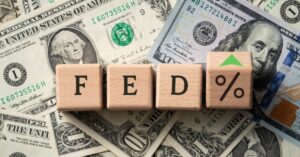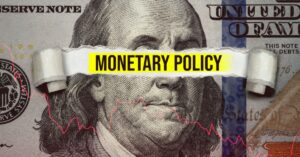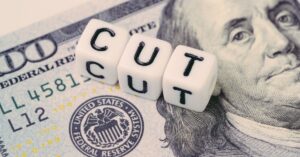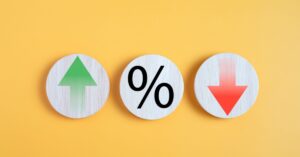The Federal Reserve, in its meeting on June 18, 2025, decided to maintain its benchmark interest rate within the range of 4.25% to 4.5%. This marks the fourth consecutive meeting where the central bank has chosen to keep rates unchanged. In my opinion, this decision reflects a delicate balancing act, as the Fed grapples with persistent inflation forecasts, a projected slowdown in economic growth, and significant uncertainties stemming from global events and domestic policy.
Federal Reserve Holds Interest Rates Steady on June 18, 2025: A Detailed Analysis
The decision to keep the federal funds rate steady, a level it has occupied since January 2025 following a series of rate reductions in late 2024, was not unexpected. Personally, I felt this cautious approach was almost a certainty given the current economic climate. What's particularly noteworthy is the unanimous nature of this decision, signaling a broad consensus among policymakers.
Despite this pause, the Fed's projections still indicate an expectation of two rate cuts before the end of 2025. However, digging deeper into the individual forecasts reveals a considerable divergence of opinion among Federal Reserve officials:
- 0 rate cuts: 7 officials
- 1 rate cut: 2 officials
- 2 rate cuts: 8 officials
- 3 rate cuts: 2 officials
Looking further down the line, the Fed anticipates the interest rate to settle in the range of 3.5%–3.75% by the close of 2026. This is a more conservative reduction compared to their projections in March 2025, suggesting a potentially slower pace of easing monetary policy. By 2027, the range could be anywhere from 2.6% to 3.9%, with the long-term neutral rate holding steady at 3% (according to the Federal Reserve Projections). To me, this wider range for 2027 highlights the inherent uncertainty in long-term economic forecasting.
Revised Economic Projections: A More Cautious Outlook
The updated economic projections released alongside the interest rate decision paint a picture of a more cautious Fed, which, frankly, aligns with my own observations of the current economic headwinds. Here’s a breakdown of the key revisions:
| Indicator | 2025 Forecast | Previous (March 2025) | 2026 Forecast |
|---|---|---|---|
| Core PCE Inflation | 3.1% | 2.8% | 2.4% |
| GDP Growth | 1.4% | 1.7% | N/A |
| Unemployment Rate | 4.5% | 4.4% | N/A |
Inflation: The Fed’s preferred inflation measure, the core Personal Consumption Expenditures (PCE) price index, is now projected to reach 3.1% by the end of 2025, a notable increase from the 2.8% forecast in March. While inflation is expected to moderate to 2.4% in 2026 and 2.1% in 2027, the upward revision for this year signals that the fight against rising prices is proving to be more persistent than initially anticipated. This is something I've been watching closely, and it reinforces my belief that getting inflation back to the 2% target will be a marathon, not a sprint.
Economic Growth: The forecast for GDP growth in 2025 has been lowered to 1.4%, down from 1.7% in March. This downward revision reflects growing concerns about a potential softening of economic activity. It's a delicate situation – the Fed needs to cool down inflation without triggering a significant recession.
Unemployment: The unemployment rate is now expected to climb to 4.5% by the end of 2025, a slight increase from the current 4.2% and the 4.4% projected earlier. While still relatively low by historical standards, this uptick suggests that the anticipated economic slowdown could lead to some job losses.
These revised projections, in my opinion, clearly illustrate the tightrope the Federal Reserve is walking. They are acknowledging the stickiness of inflation while also bracing for a potential deceleration in economic momentum.
The Reasoning Behind Maintaining the Status Quo
Several factors likely contributed to the Fed’s decision to keep interest rates steady:
- Impact of Tariff Policies: The current administration’s tariff agenda, particularly the reciprocal tariffs on goods from China and other countries, has already started to push up prices on various consumer goods, including personal computers and audio-visual equipment. The Fed anticipates further inflationary pressures in the coming months as a result of these policies. A 90-day pause on some tariffs is set to expire soon, which could exacerbate these price increases. From my perspective, these tariffs add a layer of complexity to the Fed's job, as they are dealing with price pressures that aren't solely driven by traditional monetary factors.
- Geopolitical Uncertainties: The ongoing tensions in the Middle East, especially concerning the Strait of Hormuz, introduce significant risks to global energy markets. Higher oil prices would undoubtedly fuel inflation and could force the Fed to maintain a more hawkish stance. These geopolitical factors are wild cards that are difficult for any central bank to predict or control. Personally, I always keep a close eye on these global developments, as they can have a swift and significant impact on our domestic economy.
- Lingering Economic Uncertainty: While the Fed noted that economic uncertainty has “diminished” somewhat since earlier in 2025, it still remains at an “elevated” level. Interestingly, the central bank removed previous language about risks of higher unemployment and rising inflation, perhaps signaling a slightly improved, though still cautious, outlook. I interpret this as the Fed wanting to see more data before making any significant moves.
- Labor Market Balance: Fed Chair Jerome Powell himself highlighted that the labor market is currently “in balance” and not a primary driver of inflationary pressures. This assessment likely reduces the immediate pressure on the Fed to hike rates further to cool down the economy. It’s a welcome sign that the strong labor market hasn’t translated into runaway wage growth fueling inflation.
Market Reactions: A Measured Response
The financial markets responded with a degree of calm to the Fed’s announcement and updated projections:
- Stock Markets: Major stock indexes ended the day with minimal changes. The S&P 500 edged up by 0.2% to 5,980.85, the Dow Jones Industrial Average saw a slight dip to 42,171.66, and the Nasdaq Composite gained marginally to 19,546.27. Initially, investors seemed to react positively to the unchanged interest rate, but these gains were tempered as the implications of slower growth and higher inflation forecasts began to sink in. This muted reaction, in my view, suggests that the market had largely priced in the Fed’s decision.
- Other Assets: Oil prices remained stable, holding onto recent gains driven by Middle East concerns. Treasury yields saw a slight increase, while the WSJ Dollar Index experienced a minor decline. Bitcoin prices dipped below $105,000. This mixed bag of reactions across different asset classes reflects the underlying uncertainty and the various factors at play. The fact that the S&P 500 remains just over 2% from its record high, despite all the current challenges, indicates a certain level of underlying resilience in the market.
Real-World Implications for Consumers and Businesses
The Fed’s decision to maintain elevated interest rates continues to have tangible effects on everyday individuals and businesses:
| Category | Impact | Key Rates |
|---|---|---|
| Credit Cards | High variable rates (average 20% APR) put a strain on borrowers; relief is likely delayed. | 20% |
| Auto Loans | New car loans at 7.3%, used cars at 11%; tariffs add to car prices, impacting affordability. | 7.3%, 11% |
| Mortgages | 30-year fixed at 6.91%, 15-year at 6.17%; high rates continue to challenge the housing market. | 6.91%, 6.17% |
| Student Loans | Federal rates fixed at 6.53% (until June 30), then 6.39%; limited loan forgiveness options. | 6.53%, 6.39% |
| Savings | High-yield savings accounts offer >4%, outpacing inflation, providing a benefit for savers. | >4% |
Borrowing Costs: High interest rates translate directly into higher borrowing costs for consumers. Credit card interest rates hovering around 20% APR make it more expensive to carry a balance. Auto loan rates remain elevated, and when coupled with tariff-induced increases in car prices, affordability becomes a significant issue. Similarly, high mortgage rates continue to be a major hurdle for prospective homebuyers, cooling down the housing market. Student loan borrowers face fixed rates, and the landscape for widespread loan forgiveness remains limited. For me personally, these high borrowing costs are a constant reminder of the impact of monetary policy on household budgets.
Savings Benefits: On a brighter note, those with savings in high-yield online accounts are currently enjoying returns above 4%, which is finally outpacing inflation for many. This provides a welcome benefit for individuals looking to grow their savings.
Business Challenges: Businesses, particularly small and medium-sized enterprises, face higher costs for borrowing, which can constrain investment in expansion, new equipment, and hiring. The uncertainty surrounding tariffs and the overall economic outlook further complicates their decision-making processes. As someone who follows business trends, I know these are challenging times for many companies navigating these higher costs and uncertainties.
The Fed's Communication and What Lies Ahead
Fed Chair Jerome Powell’s commentary following the meeting provided crucial insights into the central bank’s thinking:
- Inflation Expectations: Powell acknowledged that the Fed anticipates “a meaningful amount of inflation to arrive in the coming months” primarily due to the impact of tariffs and other contributing factors. This clearly signals that the Fed remains vigilant about the risk of persistent price pressures and underscores the rationale for their cautious approach.
- Rate Cut Timing: The consensus among economists currently points towards a low probability of a rate cut at the upcoming July meeting (July 29–30). However, the likelihood of a rate cut at the September 17 meeting is estimated to be around 60%, according to FactSet. This suggests that the Fed is likely to wait for more data on the inflation front and the overall economic trajectory before considering any easing of monetary policy.
- Policy Stance: Powell emphasized that the current monetary policy stance is “well-positioned” to support a strong economy with stable prices and a healthy labor market, despite the external political pressures. This statement reinforces the Fed's commitment to its dual mandate, independent of political considerations.
The Fed’s official statement described the economy as growing at a “solid pace” with a strong labor market but acknowledged “elevated” uncertainty, indicating a “wait-and-see” approach to assess the incoming economic data. This cautious stance, in my opinion, is prudent given the complex interplay of domestic and global factors currently influencing the economy.
The Broader Economic and Political Context
The Fed’s decisions are never made in a vacuum. They occur within a dynamic economic and political environment:
- Tariff Impacts: President Trump’s tariffs, even with a temporary easing on some Chinese goods until August, have already contributed to higher prices for electronics and other imported goods. The Fed anticipates these inflationary effects to be most pronounced over the summer, potentially raising concerns about stagflation. While some analysts believe the impact might be temporary, others warn of more lasting price pressures. It's a debate with significant implications for the Fed's next moves.
- Geopolitical Risks: The ongoing instability in the Middle East, particularly around the Strait of Hormuz, continues to pose a threat to global energy supplies. Any significant disruption could lead to a sharp increase in oil prices, further complicating the inflation outlook and potentially limiting the Fed’s flexibility to cut rates.
- Political Pressure: The Federal Reserve has faced public criticism from President Trump, who has advocated for substantial interest rate cuts. He has even suggested the possibility of appointing himself to the Fed. Despite this pressure, Fed Chair Powell has consistently reiterated the central bank’s commitment to its dual mandate and its independence in setting monetary policy. This independence is crucial for maintaining the credibility and effectiveness of the Federal Reserve.
In Summary
The Federal Reserve’s decision on June 18, 2025, to maintain the federal funds rate in the 4.25%–4.5% range underscores a cautious and data-dependent approach in the face of a complex economic landscape. With inflation expected to edge higher, economic growth projected to slow, and unemployment anticipated to rise slightly, the Fed is prioritizing the battle against inflation while carefully monitoring potential risks to economic activity.
The projected two interest rate cuts later in 2025 offer a glimmer of hope for lower borrowing costs, but the exact timing will hinge on incoming economic data, particularly concerning the impact of tariffs and geopolitical developments.
For consumers, the persistence of high interest rates will continue to strain budgets on credit cards, auto loans, and mortgages, although savers will benefit from higher yields on savings accounts. Businesses will likely face ongoing challenges related to borrowing costs and economic uncertainty, potentially impacting their investment and hiring decisions.
Position Your Portfolio Ahead of the Fed’s Next Move
The Federal Reserve’s next rate decision could shape real estate returns through the rest of 2025. Whether or not a rate cut happens tomorrow, smart investors are acting now.
Norada Real Estate helps you secure cash-flowing properties in stable markets—shielding your investments from volatility and interest rate swings.
HOT NEW LISTINGS JUST ADDED!
Talk to a Norada investment counselor today (No Obligation):
(800) 611-3060
Recommended Read:
- Key Interest Rates Predictions for Today – June 18, 2025
- Inflation is the Biggest Concern for Fed's Rate Cut Decision Today – June 18, 2025
- What are the Odds of a Fed Rate Cut Today, June 18, 2025?
- Interest Rate Predictions for the Next 3 Years: 2025, 2026, 2027
- When is Fed's Next Meeting on Interest Rate Decision in 2025?
- Interest Rate Predictions for the Next 10 Years: 2025-2035
- Will the Bond Market Panic Keep Interest Rates High in 2025?
- Interest Rate Predictions for 2025 by JP Morgan Strategists
- Interest Rate Predictions for Next 2 Years: Expert Forecast
- Fed Holds Interest Rates But Lowers Economic Forecast for 2025
- Fed Indicates No Rush to Cut Interest Rates as Policy Shifts Loom in 2025
- Fed Funds Rate Forecast 2025-2026: What to Expect?
- Interest Rate Predictions for 2025 and 2026 by NAR Chief
- Market Reactions: How Investors Should Prepare for Interest Rate Cut
- Impact of Interest Rate Cut on Mortgages, Car Loans, and Your Wallet











